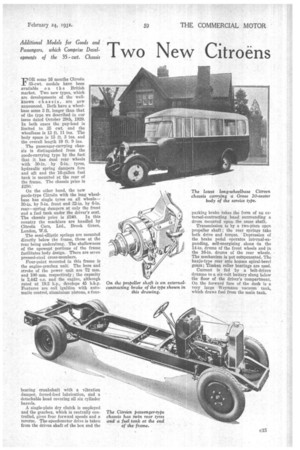Two New Citroens
Page 65

If you've noticed an error in this article please click here to report it so we can fix it.
Additional Models for Goods and Passengers, which Comprise Developments of the 35cwt. Chassis FOR some 16 months Citran 35-cwt. models have been available on the British market. Two new types, which are developments of the wellknown chassis, are now announced. Both have a wheelbase some 3 ft. longer than that of the type we described in our issue dated October 29th, 1929. In both cases the pay-load is limited to 35 cwt. and the wheelbase is 13 ft. 11 ins. The body space is 15 ft 3 ins. and the overall length 19 ft. 9 ins.
The passenger-carrying chassis is distinguished from the goods-carrying type by the fact that it has dual rear wheels with 30-in. by 5-in. tyres, hydraulic spring dampers fore and aft and the 16-gallon fuel tank is mounted at the rear of the frame. The chassis price is On the other hand, the new goods-type Citro6n with the long wheelbase has single tyres on all wheels30-in. by 5-in, front and 32-in. by 6-in. rear—spring dampers at only the front and a fuel tank under the driver's seat.
The chassis price is £240. In this country the machines are handled by Citran Cars, Ltd., Brook Green, London, W.6. The semi-elliptic springs are mounted directly below the frame, those at the rear being underslung. The shallowness of the upswept portions of the frame facilitates body design. There are seven pressed-steel cross-members. Four-point mounted in this frame is the engine-gearbox unit: The bore and stroke of the power unit are 72 mm. and 100 mm. respectively ; the capacity is Z442 c.c. and the engine, although rated at 19.3 h.p., develops 45 b.h.p. Features are coil ignition with automatic control, aluminium pistons, a four bearing crankshaft with a vibration damper, forced-feed lubrication, and a detachable head covering all six cylinder barrels.
A single-plate dry clutch is employed and the gearbox, which is centrally controlled, gives four forward speeds and a reverse. The speedometer drive is taken from the driven shaft of the box and the parking, brake takes the form of an external-contracting band surrounding a drum mounted upon the same shaft.
Transmission is by a two-piece open propeller shaft ; the rear springs take both drive and torque. Depression of the brake pedal operates internal-expanding, self-energizing shoes in the 14-in, drums of the front wheels and in the 16-in, drums of the rear wheels. The mechanism is not compensated. The banjo-type rear axle houses spiral-bevel gears; Timken roller bearings are used.
Current is fed by a belt-driven dynamo to a six-volt battery slung below the floor of the driver's compartment. On the forward face of the dash is a very large Weymann vacuum tank, which draws fuel from the main tank.




















































































































